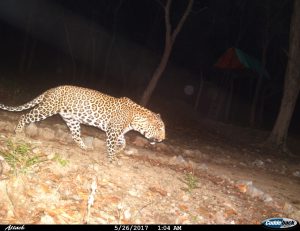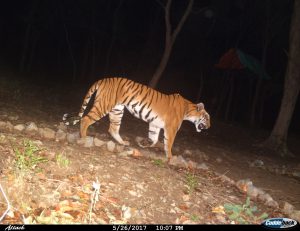In December 2016, we decided to set up camera traps to understand the effect we had on the ecosystem at Khetiyo. You can read about our initial findings here. The curious case of the 3 cats had to be solved. So we continued with the cam trapping and in fact, this time we set up two more. So in all we had 4 camera traps in 4 corners of the estate, South East – referred to as plot 1, North East referred to as Plot 2, South – referred to as plot 3 and the west- referred to as plot 4.
A male tiger typically has a territory that encompasses several females. Over a period of time they would have done a sortie of their entire range, marking it with claw marks, urine and droppings. So the frequency with which a tiger gets caught in the same camera trap would give us a hint how large a range it had. The only plausible explanation we had about the three tigers was that the big male – referred as male1, was the dominant one, the female was the resident tigress and the younger male – referred to as male2 was an intruder in search of his own range. This meant, we would expect the female to be caught a lot more frequently than male1. male2 was not expected at all as the male1 would find and eliminate all threats – atleast thats the understanding we have in wildlife circles.
In late May DP went back to collect the pictures. I knew we would have to sort through tons of images to find anything interesting. The treasure trove we uncovered was astounding to say the least. As the owner of the estate, I have spent many nights there. I always thought of Khetiyo to be an amazing window into wildlife viewing but i never realised it had over the years become a haven for so many big carnivores to cross paths. I will write more about it in coming articles but the most interesting find was that of the resident tigress – the female and a leopard (the new find) – I ve named him zorro – getting caught at the exact same spot over a 21 hour gap.


All conventional knowledge and NatGeo documentaries suggest that these two cats are sworn enemies and if they ever cross paths its a fight to the finish. They share most of their prey base and are extremely territorial. One could even go as far as to say that a leopard would never dare to infringe onto a tiger’s territory, leave alone the female who still had a sub adult to take care of and definitely not when she s in the vicinity. So let me outline the events. This happened in plot2. We have a camera trap set up on the trail such that there s a clear line of sight from the machaan. The idea was that guests could silently wait on the machaan and the flash of the camera trap can alert them towards movements. on 26th May 2017 at 1.06AM zorro was caught in the cam trap. 21 hours later at 10 PM on the same day, the female was captured at the exact same spot. Leopards are super shy cats. They don’t just carelessly walk out in the open, especially when there are tigers around. Its hard to believe that it wasn’t aware of the tiger s presence in the area. Assuming that it knew, what prompted the leopard to walk out into the open grassland, atleast 30 feet away from the nearest foliage. May be that was the key – it was banking on the open line of sight – a tiger couldn’t just ambush it. Inspite of this, the absolute lack of caution was something that could not be ignored. Was the female a super tolerant queen who was ok with not just other tigers in the area but also leopards. But this is a base instinct. I doubt if a wild animal could fight out a basic instinct – after all one can’t fight evolution. Or was there an order to the madness. In summers, the entire landscape of the mandal valley undergoes a transformation – the green cover turns golden with dried sal leaves all over, the springs reduce to a trickle and the only permanent water hole is the river itself. Is that the pact – the unspoken but understood covenant of the jungle – in summers all is fair. Boundaries become transparent, cats become more tolerant – all in the interest of survival of the eco system. Talk of taking one for the team. And as it happens, khetiyo estate stands bang in between the river and the Luthiya ridge. This meant, all animals on the side of the ridge have to cross the estate to reach the river. That explains it, although its just theory right now.
Earlier, Khetiyo was nothing more than a dense mass of lantana – something the cats absolutely hate. So to cross the estate, elephants and cats would take one of the two dried up nullahs to the east and west of the estate. We call them the East Nullah and West Nullah respectively. But ever since we undertook the restoration of the estate, we phased in the native species of grasses by clearing out the lantana. This meant the deer took up residence first. To them, it was nice expanse of open grassland with a select few harmless humans around. It felt safe perhaps. No bushes around for the male1 to suddenly ambush them. So come 9pm every night, a few hundred deer stream down the hills to graze in the estate in the area the separates the guest house from the staff quarters. With the herbivores coming, the carnivores can’t be far behind – Kenneth Anderson. The elephants come down as well. Quite often we find them using our open tank. The fundamental idea of leaving passive markers of human presence in an open grassland to draw the herbivores seemed to have played out well. When Shekhar had initially suggested marking the trails and making sure the staff walks on the trails atleast once a day, i dint quite understand it but i see the bigger picture now. But all said and done, we hadn’t expected a coexistence of leopards and tigers. May be this is just restricted to the summer. The traps are still in place, we will find out. But it warms my heart to think, that in spite of all these years of discovery, there are still some secrets that the jungle chose not to reveal. Mystery remains in this world.!


